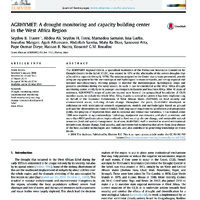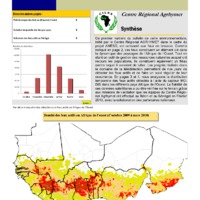Recherche
2 items
AGRHYMET: Adrought monitoring and capacity building center in the West Africa Region
The AGRHYMET Regional Center, a specialized institution of the Permanent Interstates Committee for Drought Control in the Sahel (CILSS), was created in 1974 at the aftermaths of the severe droughts that affected this region in the early 1970s. The mission assigned to the Center was to train personnel, provide adequate equipment for the meteorological and hydrological stations networks, and set up regional and national multidisciplinary working groups to monitor the meteorological, hydrological, crops and pastures conditions during the rainy season. As such, it can be considered as the West Africa drought monitoring center, similarly to its younger counterparts in Eastern and Southern Africa. After 40 years of existence, AGRHYMET’s scope of activities expend now beyond the geographical boundaries of CILSS member states, to include the whole West Africa thanks to several initiatives it has been implementing on behalf of the Economic Commission of West African States (ECOWAS) on food security and environmental issues, including climate change. Throughout the years, AGRHYMET developed, in collaboration with international research organizations, models and methodologies based on ground and satellite observations to monitor rainfall, food crop water requirements satisfaction and prospective yields, the progress of vegetation front and its seasonal and interannual variations. It has trained about 1200 new experts in agrometeorology, hydrology, equipment maintenance, and plant protection, and more than 6000 professionals on topics related to food security, climate change, and sustainable natural resources (land and water) management. As of now, AGRHYMET staff is involved in several international initiatives on climate change, food security, and environmental monitoring that allow them keep abreast of the best available technologies and methods, and also contribute to generating knowledge on those issues.
Bulletin de veille environnementale au sahel et en Afrique de l’Ouest : suivi des feux
La tendance des feux actifs au cours de la saison 2019-2020 dans l’ensemble des pays CILSS/CEDEAO est à la baisse, de l’ordre de 2% par rapport à la moyenne dans des 5 dernières saisons (2014 à 2019). En effet, les occurrences de feux élevées dans les pays côtiers (Guinée, Togo, Côte d’Ivoire, Bénin, Libéria et Sierra Leone) restent inférieures par rapport cette moyenne. La répartition mensuelle des occurrences de feux montre que cette baisse globale cache d’importantes variabilités/ contrastes selon les zones bioclimatiques, les pays et les mois. A l’exception du Burkina Faso tous
les pays du front sahélien ont enregistré plus de feux (sur la saison 2019-2020) par rapport à la moyenne des 5 dernières saisons. Cette situation pourrait s’expliquer par le manque de contrôle dû au contexte sécuritaire, aggravé par les mesures du confinement liées à la pandémie du COVID-19. Localement, des baisses sont observées dans le sud-est du Sénégal, à l’extrême ouest du Mali, en Guinée, le nord de la Sierra Leone, le nord-est de la Côte d’Ivoire, la moitié nord du Ghana,
une bonne partie du Togo, la zone du Parc de W des trois pays (Bénin, Burkina, Niger) ; le sud et
l’extrême nord-est du Nigeria et le sud du Tchad. Ailleurs, on note des hausses de détections des foyers de feux voire même équivalentes à la moyenne des 5 dernières années

